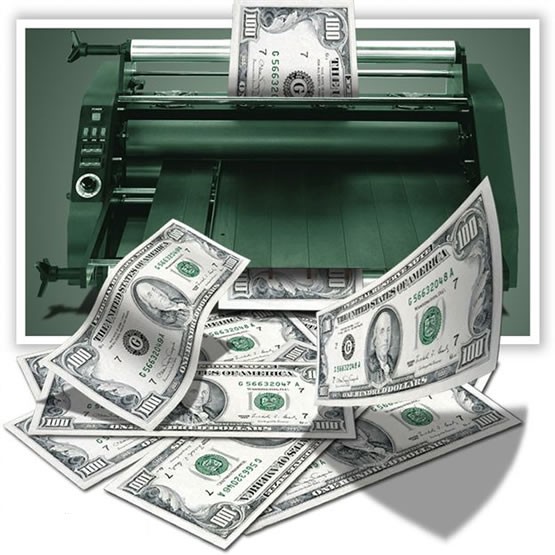Printing Money
Post on: 5 Апрель, 2015 No Comment

Printing Money
Isn’t that just printing money? Here is a quick, and hopefully simple, primer on what central banks do.
Central banks print money. They are responsible for issuing a country’s legal tender (banknotes and bank deposits with the central bank) and regulating its value. Most of what we call money is actually privately produced (deposits at commercial banks, credit and debit cards, paypal, etc.) but tied to the money printed by each country’s central bank by the public’s demand that it be redeemable for the central bank’s money. There are a few exceptions to this demand by the market, such as bitcoin (see: the-rise-of-the-bitcoin-virtual-gold-or-cyber-bubble ), but they shall ever remain unimportant fads. There is never a question about whether central banks print monetary or not. It is their responsibility to do so. This is as true for a pure gold standard or other fixed exchange rate monetary regimes, as for the variety of fiat money regimes (from monetary targets to inflation targets to flying by the seat of their pants day-to-day).
The important and proper question about a central bank’s behavior is what guides its decisions about when and how much money to print. A secondary question is what does it buy when it issues money (there are no helicopters that drop it from the sky)?
The gold standard: Under a gold standard the central bank buys gold with the money it prints and is legally bound to buy that money back with gold at the same price whenever anyone holding its money wants to redeem it. While this is still printing money, the supply is determined by the preferences of the market (each and every one of us) to hold and use that money. Such central banks have no monetary “policy” in the usual sense. They passively supply whatever amount of money the public demands.
Fiat money: If the central bank issues money with no obligation to redeem it for anything in particular nor at a particular price, its value is determined in the market by its supply and demand. The amount supplied by the central bank relative to the market’s demand for it will determine is value (the price level). Monetary policy consists of the decisions made by central banks that determine the amount of the money they supply and manner in which they supply it.
The public’s demand for money reflects its convenience for making payments, its expected value when exchanged for goods and services, and the opportunity cost of holding it (inventory costs, i.e. the interest rate that could have been earned on holding wealth in other forms). Rapidly changing payment technology (debit/credit cards, Paypal, e-money, etc.) has a profound impact on this demand. There is a vast academic literature on this subject. Unlike any other good or service money’s value derives solely from what it can be exchanged for or more specifically from the economy it brings to exchange/trade. Fiat currency is always useable and thus “redeemable” for the payment of taxes and other obligations to the government that issued it. These obligations are denominated (valued) in the same units as the currency. These guaranteed uses of fiat money anchor its demand and thus value in the same way that the demand for gold for jewelry and other non-monetary uses anchors its value. Bitcoin has no alternative use and thus has no anchor to its value.
Central banks have learned the value of establishing clear rules for issuing money, such as targeting the rate at which the money supply (by one definition or another) grows, or targeting nominal income, or inflation. These rules guide how much money they “print.” They also influence the public’s demand for money by informing its expectations of the central banks actions. The policy regime adopted—rule—determines the behavior of the money supply and thus its value (or visa versa). The supply of bitcoin also follows a well-defined rule, but its demand is unanchored. The fact that the central bank is printing money is irrelevant by itself.
A secondary consideration is what it is that the central bank buys with the money it prints. Under a gold standard it buys gold. Under a fiat money standard central banks generally buy government securities because these securities are generally of unquestioned safety and in most countries have the deepest and most liquid secondary markets. Central banks also traditionally adhere to a “bills only” policy, i.e. they buy short-term government security, in order not to interfere with the market’s determination of the term structure of interest rates, i.e. the relationship of interest rates on securities with longer maturities relative to those with shorter maturities. In a free market, rates on longer maturities are determined by the expected value of overnight rates over the period in question plus a risk premium for the uncertainty over the behavior of overnight rates.
Whatever the ultimate or intermediate targets of monetary policy, most central banks in recent decades have pursued them by targeting a short-term interest rate, their so-called “operating target.” The Federal Reserve targets the overnight interbank rate, the so-called “federal funds rate,” as its approach to targeting the money supply, nominal income, or inflation. Given all other market factors, a particular fed funds rate target will result from and result in a particular rate of growth in the money supply.
Because most money and related means of payment are privately produced by banks or is ultimately settled through banks, and because banks only keep a small amount of the money produced by their central banks for which bank deposits are redeemable (the so-called “fractional reserve banking system”), central banks have also been given the role of insuring that banks have sufficient liquidity to function smoothly. They are mandated to lend to solvent but illiquid banks when banks need to convert loans into cash to accommodate deposit withdrawals (the so-called “lender of last resort” function).
As more and more central banks successfully adopted the techniques of inflation targeting and most of the rest fixed the exchange rate of their currencies to an inflation targeting currencies such as the U.S. dollar or the Euro, the world entered a long period dubbed “the great moderation.” However, the long period of very low interest rates following the bursting of the “dot com” bubble produced the housing price bubble in many locations in the U.S. and Europe. Its collapse in 2007-8 plunged much of the Western world into the long, Great Contraction.

Monetary Policy Plus (MP+): In the last few years the Federal Reserve, the European Central Bank (ECB) and other central banks have undertaken many non-traditional actions in an effort to help lift their respective economies out of recession. In the early days of the serious liquidity crunch following the collapse of Lehman Brothers in September 2008, the Fed, ECB, Bank of England and a few other central banks very successfully pumped needed liquidity into their financial systems by expanding the number of counterparties they would lend to, increasing the eligible collateral, and entering into currency swap arrangements to supply dollar liquidity to foreign banks.
However, after unblocking the flow of funds between banks and other financial firms, the Fed’s concern shifted to fighting deflation, then to reviving economic activity. After driving its operating target to almost zero, the Fed continued increasing monetary growth beyond the rate resulting from a zero fed funds target and dubbed it quantitative easing. However, the channels through which monetary policy is traditionally transmitted to the economy (interest rate, credit, asset price, portfolio/wealth effects, exchange rate channels) seemed ineffective. Thus, the Fed began to purchase non-traditional, financial instruments, such as Mortgage Backed Securities (MBSs) and longer-term government securities, in an effort to keep mortgage interest rates low and to encourage the flow of funds into the mortgage market and stimulating investment more generally. These quasi-fiscal policy measures do not square easily with the Fed’s legal mandates of price stability and employment.
works.bepress.com/warren_coats/28/ ). It is attempting to stimulate an economy that lacks a clear policy environment that would encourage more investment rather than one suffering from inadequate liquidity. While market measures of inflation expectations remain very low, long periods of very low interest rates influence the capitalized value of income streams. A given monthly mortgage payment will purchase a more expensive house when interest rates are lower. What people and firms invest in is distorted toward more capital-intensive projects than are economically efficient and justified at normal rates of interest. Pension funds and other endowments lose income that must be made up somehow (often by moving into riskier investments). Asset price bubbles emerge. On top of these economic risks, the Fed’s need to unwind its huge portfolio of securities (purchased by printing money) when the economy recovers more fully is becoming more and more challenging.
Moreover, the policies of one central bank can affect the exchange rate of its currency if its policies are not coordinated with those of other central banks. This can either improve or worsen the balance of payments between countries (balance of imports and exports). The very wide swings over the last decade in the exchange rate of the US dollar with the Euro, for example, cannot be justified by economic fundamentals and is very disruptive to trade and international capital movements. Recent monetary policy initiatives by the Bank of Japan raise such concerns.
In short, the problem is not that the Fed and other central banks are printing money. The problem is the amount they print and their conceit that they can do more to help the real economy than they really can, thus adding to the market’s uncertainty over the economic, policy, and financial environment in which their decisions to spend and invest must be made. The solution is to reestablish a hard anchor for monetary policy that allows the supply of money to be market determined (as proposed in my: Real SDR Currency Board. paper).
The fantasy of a purely private money that would overcome the weaknesses of government money, remains for the foreseeable future a utopian fantasy: The Future of Money. But those of you who enjoy fantasy, might enjoy the following story by Neal Stephenson: The Great Simoleon Caper .














